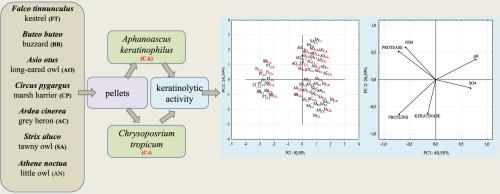当前位置:
X-MOL 学术
›
Int. Biodeterior. Biodegrad.
›
论文详情
Our official English website, www.x-mol.net, welcomes your
feedback! (Note: you will need to create a separate account there.)
Degradation of chicken feathers by Aphanoascus keratinophilus and Chrysosporium tropicum strains from pellets of predatory birds and its practical aspect
International Biodeterioration & Biodegradation ( IF 4.1 ) Pub Date : 2020-07-01 , DOI: 10.1016/j.ibiod.2020.104968 Justyna Bohacz , Teresa Korniłłowicz-Kowalska , Ignacy Kitowski , Anita Ciesielska
International Biodeterioration & Biodegradation ( IF 4.1 ) Pub Date : 2020-07-01 , DOI: 10.1016/j.ibiod.2020.104968 Justyna Bohacz , Teresa Korniłłowicz-Kowalska , Ignacy Kitowski , Anita Ciesielska

|
Abstract The present study is the first report on the biodegradation of native keratin by fungi isolated from food pellets of birds of prey. The aim of the study was to evaluate the diversity of keratinolytic activity of 2 fungal species, Aphanoascus keratinophilus and Chrysosporium tropicum, isolated from pellets of raptors and to find a relationship between the origin of fungal strains and their keratinolytic activity. The feather weight loss ranged from 60% to 75% for A. keratinophilus and from 55% to 70% for Ch. tropicum. Strains isolated from kestrel and buzzard pellets transformed feathers after 6 weeks into a soluble protein form in the range from 11% to 17% and 12%–17%, respectively. A. keratinophilus strains transformed feather N into N–NH4+ maximally in 53% and minimally in 20%, whereas Ch. tropicum strains converted from approx. 3%–42%. Feather S was transferred to the medium as S–SO42- after 42 days in 74% by A. keratinophilus and from 2% to 68% by Ch. tropicum strains. The effectiveness of fungal strains isolated from buzzard and kestrel pellets, was generally higher than that of strains isolated from owl pellets. The passage of the tested fungal strains through the gastric barrier and their thermo-tolerance allow a conclusion that pellet-derived keratinolytic fungi (especially from diurnal raptors) are a suitable inoculum material for keratin waste composting.
中文翻译:

Aphanoascus keratinophilus和Chrysosporium tropicum菌株对掠食性鸟类颗粒中鸡羽毛的降解及其应用
摘要 本研究首次报道了从猛禽的食物颗粒中分离的真菌对天然角蛋白的生物降解。该研究的目的是评估从猛禽颗粒中分离出的 2 种真菌 Aphanoascus keratinophilus 和 Chrysosporium tropicum 的角质溶解活性的多样性,并找出真菌菌株的起源与其角质溶解活性之间的关系。A. keratinophilus 的羽毛重量损失为 60% 至 75%,Ch 的羽毛重量损失为 55% 至 70%。热带。从红隼和秃鹰颗粒中分离的菌株在 6 周后将羽毛转化为可溶性蛋白质形式,其含量分别为 11% 至 17% 和 12%–17%。A. keratinophilus 菌株将羽毛 N 转化为 N-NH4+ 的比例最高为 53%,最低为 20%,而 Ch。tropicum 菌株从大约转化而来。3%–42%。42 天后,羽毛 S 以 S-SO42- 的形式转移到培养基中,A. keratinophilus 占 74%,Ch 占 2% 至 68%。热带菌株。从秃鹰和红隼颗粒中分离的真菌菌株的有效性通常高于从猫头鹰颗粒中分离的菌株。测试的真菌菌株通过胃屏障及其耐热性可以得出结论,颗粒衍生的角质溶解真菌(特别是来自昼夜猛禽)是角蛋白废物堆肥的合适接种材料。
更新日期:2020-07-01
中文翻译:

Aphanoascus keratinophilus和Chrysosporium tropicum菌株对掠食性鸟类颗粒中鸡羽毛的降解及其应用
摘要 本研究首次报道了从猛禽的食物颗粒中分离的真菌对天然角蛋白的生物降解。该研究的目的是评估从猛禽颗粒中分离出的 2 种真菌 Aphanoascus keratinophilus 和 Chrysosporium tropicum 的角质溶解活性的多样性,并找出真菌菌株的起源与其角质溶解活性之间的关系。A. keratinophilus 的羽毛重量损失为 60% 至 75%,Ch 的羽毛重量损失为 55% 至 70%。热带。从红隼和秃鹰颗粒中分离的菌株在 6 周后将羽毛转化为可溶性蛋白质形式,其含量分别为 11% 至 17% 和 12%–17%。A. keratinophilus 菌株将羽毛 N 转化为 N-NH4+ 的比例最高为 53%,最低为 20%,而 Ch。tropicum 菌株从大约转化而来。3%–42%。42 天后,羽毛 S 以 S-SO42- 的形式转移到培养基中,A. keratinophilus 占 74%,Ch 占 2% 至 68%。热带菌株。从秃鹰和红隼颗粒中分离的真菌菌株的有效性通常高于从猫头鹰颗粒中分离的菌株。测试的真菌菌株通过胃屏障及其耐热性可以得出结论,颗粒衍生的角质溶解真菌(特别是来自昼夜猛禽)是角蛋白废物堆肥的合适接种材料。











































 京公网安备 11010802027423号
京公网安备 11010802027423号